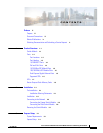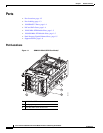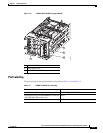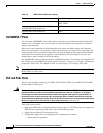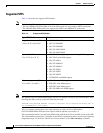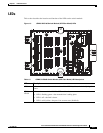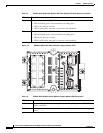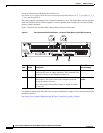
1-5
Cisco Connected Grid Ethernet Switch Module Interface Card Getting Started Guide
OL-23421-02
Chapter 1 Product Overview
Ports
–
power reservation
–
per-port power policing
On the GRWIC-D-ES-2S-8PC model (Copper model), the first four 10/100BASE-T ports (FE0/1,
FE0/2, FE0/3, FE0/4) are PoE+ ports. A maximum of two PoE+ ports or four PoE ports can be
supported at one time.
For information about configuring and monitoring PoE/PoE+ ports, see the “Interface Configuration”
chapter of the Cisco Connected Grid Ethernet Switch Module Interface Card Software Configuration
Guide on Cisco.com.
For information about port connections and port specifications, see the “Connecting Devices to the
Switch Module” section on page 4-4 and the “Cable and Connectors” appendix.
Note The output of the PoE+ circuit has been evaluated as a Limited Power Source (LPS) per IEC 60950-1.
10/100 Mb/s SFP Module Slots
The IEEE 802.3u 100 Mb/s SFP module slots provide full-duplex 100 Mb/s connectivity over
multi-mode (MM) fiber cables or single-mode (SM) fiber cables. These ports use a SFP fiber-optic
transceiver module that accepts a dual LC connector. Check the SFP specifications for the cable type and
length.
100/1000 Mb/s SFP Module Slots
The IEEE 802.3u 1000 Mb/s SFP module slots provide full-duplex 100 or 1000 Mb/s connectivity over
multi-mode (MM) fiber cables or single-mode (SM) fiber cables. These ports use a SFP fiber-optic
transceiver module that accepts a dual LC connector. Check the SFP specifications for the cable type and
length.
Dual-Purpose Gigabit Ethernet Ports
You can configure the dual-purpose ports on the switch as either 10/100/1000 Ethernet ports or as SFP
module ports. You can set the 10/100/1000 Ethernet ports to autonegotiate, or you can configure them
as fixed 10, 100, or 1000 Mb/s Ethernet ports.
By default, the switch selects the medium for each dual-purpose port (10/100/1000BASE-T or SFP).
When a link is achieved on one media type, the switch disables the other media type until the active link
goes down. If links are active on both media, the SFP module port has priority, but you can use the
media-type interface configuration command to manually designate the port as an RJ-45 port or an SFP
port.
You can configure the speed and duplex settings consistent with the selected media type. For information
on configuring interfaces, see the “Interface Configuration” chapter of the Cisco Connected Grid
Ethernet Switch Module Interface Card Software Configuration Guide on Cisco.com.
For more information on the SFP module ports see the “Supported SFPs” section on page 1-6 and the
information on the SFP modules connectors and cables in the “Cable and Connectors” appendix.



